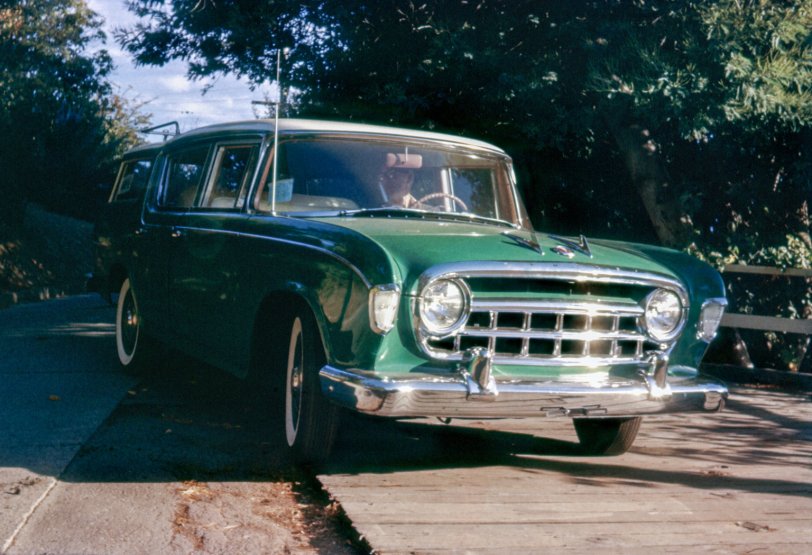


Framed or unframed, desk size to sofa size, printed by us in Arizona and Alabama since 2007. Explore now.
Shorpy is funded by you. Patreon contributors get an ad-free experience.
Learn more.

- Famous Hollywood faces
- Not just S&P
- re: Those things in the jar
- Up In Smoke
- Medical Smoking
- Quick fix
- A Quink Comment
- If You’re Like Me, Never
- Delivering the News
- U.S.A.
- S&P
- 1940 Zenith radio model 6G601
- Quality goes in before the name goes on!
- Snazzy skirt
- Carbon Arc Lamps
- Illuminate us
- I remember it well
- I can't prove it
- Complicated then, forgotten now
- Bryan-Stevenson
- Skinny is as skinny does
- How do you rest in peace
- Riding the footboards
- Alas, hidden from view
- Baldwin Diesels
- Exclusive pump
- Bananas, Oysters and Smokey Joe
- Details, Details
- What's that building to the left of the tower?
- Coal Barges
Print Emporium
Our New Car: 1956

One early September morning in 1956, my father pilots our brand new Hudson Rambler from its docking bay preparatory to its maiden voyage. Yes, I said Hudson Rambler. The distinctive front end was patterned after that of the Pinin Farina-designed Nash-Healey sports car. View full size.
Ramblerin' Man
My dad was a diehard Rambler man. There were Nashes before my day, then in '57 he bought a brand new wagon much like the one in the picture, but black with white roof and red side trim. Quite striking. Next came a new '59 Ambassador Custom Country Club. What a beast. 327 4V, 270 bhp. Electric windows, seat belts, headrests, push button transmission, fully reclining seats, continental tire, yada yada yada. A '65 Ambassador wagon came next and lasted him for over 300,000 miles. The last one we had was a '68 AMX 390 he bought for my mom. I got the '59 for high school use, but good old mom let me take the AMX on occasion. Dad made my sisters and brother buy Ramblers. At one point we had five of them in the family. My brother was not pleased with his '62 American.
Rambling
I learned to drive on a 1962 Rambler with a pushbutton automatic transmission on the dash. That thing was a tank! Wouldn't go much above 40, so Dad figured it was safe to let us drive it. We had a '59 Rambler station wagon when I was in grade school - but it didn't have the massive amounts of chrome shown here.
Hudson-Nash merger
Hudson merged with Nash in late 1953, moving production to Kenosha after closing its Detroit plant in October 1954. The 1955 Hudson was a restyled Nash with Hudson's '54 instrument cluster, but retained "Dual-Safe" brakes and Hudson front suspension. You could get a Packard V-8 in the car.
1956 saw "modest" styling and engineering changes and further declining sales. 1957 introduced AMC's new four-barrel, dual exhaust 327-c.i. V-8. It as Hudson's last year. AMC dropped both Hudson and Nash, carrying on with the Rambler.
Metropolitans were sold by both Hudson and Nash, but the car is usually associated with the latter. Beep-beep!
Steve Miller
Someplace near the crossroads of America
Hey tterrace
I’ll show him that a Cadillac
Is not a car to scorn.
Beep beep. Beep! Beep!
His horn went beep beep beep.
Shifting Ramblers
Perhaps you can clear up the urban legend about Ramblers having tricky transmissions?
The '56 had a 3-speed manual transmission, the '66 had an automatic, both apparently Borg Warner. Except for the '66 blowing its transmission on I-580 in Oakland in 1971 (yes, I have Kodachromes of it), my father had no complaints.
Beep Beep Beep
Perhaps you can clear up the urban legend about Ramblers having tricky transmissions? I heard one of them had to chase down a Cadillac to get advice on shifting gears.
Rambler roots
Ramblers were actually a Nash product originally, debuting in 1950. Nash and Hudson merged in 1954 to form American Motors, and Ramblers were produced with both emblems until the Nash and Hudson lines were discontinued. Ours was a Hudson Rambler because we bought it from a Hudson dealer. Metropolitans were also a Nash product initially.
Rambler
Think the Hudson name was on the Rambler for only a couple of years, until their merger with Nash. The first Metropolitans were also manufactured by Hudson.
























On Shorpy:
Today’s Top 5